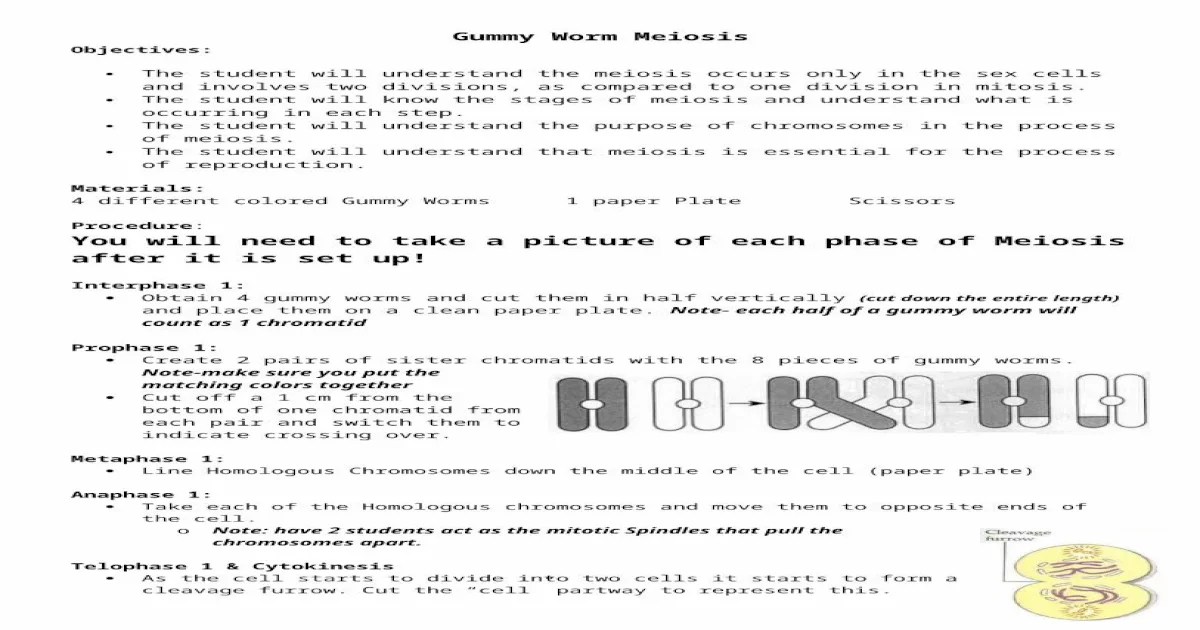Embark on a fascinating journey with the Gummy Worm Meiosis Lab Answer Key, where the complex process of meiosis unfolds in a tangible and engaging manner. This innovative tool empowers students to visualize and comprehend the intricate mechanisms that govern genetic inheritance.
Through the hands-on simulation of meiosis using gummy worms, the lab not only simplifies the understanding of genetic inheritance but also underscores the significance of accurate chromosome pairing and separation in ensuring the production of viable gametes.
Meiosis Lab Introduction

The meiosis lab aims to provide a hands-on understanding of the process of meiosis, a critical mechanism in genetic inheritance. Meiosis is the specialized cell division that produces gametes (eggs and sperm) in sexually reproducing organisms. Understanding meiosis is essential for comprehending the principles of genetics and the transmission of genetic information from one generation to the next.
Gummy Worm Meiosis Model: Gummy Worm Meiosis Lab Answer Key

The gummy worm meiosis model is a simplified representation of the complex process of meiosis. It uses gummy worms to represent chromosomes, making it easier to visualize the different stages of meiosis. The model demonstrates how chromosomes pair up, exchange genetic material, and separate into gametes with half the number of chromosomes as the parent cell.
Meiosis Process Simulation, Gummy worm meiosis lab answer key
Materials:
- Gummy worms (different colors)
- Scissors
- Paper
- Pen or pencil
Procedure:
- Prophase I:Cut a pair of gummy worms of different colors in half lengthwise to represent homologous chromosomes. Connect the ends of the homologous chromosomes to form tetrads.
- Metaphase I:Line up the tetrads in the center of the paper.
- Anaphase I:Separate the homologous chromosomes and move them to opposite ends of the paper.
- Telophase I:Form two new cells, each containing one set of chromosomes.
- Prophase II:Cut each chromosome in half to form chromatids.
- Metaphase II:Line up the chromatids in the center of the paper.
- Anaphase II:Separate the chromatids and move them to opposite ends of the paper.
- Telophase II:Form four new cells, each containing half the number of chromosomes as the parent cell.
Meiosis Results Analysis
The results of the gummy worm meiosis simulation should show the formation of four gametes, each with half the number of chromosomes as the parent cell. The gametes should have a random combination of genetic material from both parents, demonstrating the role of meiosis in creating genetic diversity.
Meiosis Applications
Meiosis has numerous applications in genetics and genetic engineering:
- Genetic Diversity:Meiosis contributes to genetic diversity by shuffling and recombining genetic material, creating offspring with unique genetic combinations.
- Evolution:Meiosis is a driving force behind evolution, providing the raw material for natural selection to act upon.
- Genetic Engineering:Meiosis is used in genetic engineering techniques such as in vitro fertilization (IVF) and embryo selection.
Question & Answer Hub
What is the purpose of the Gummy Worm Meiosis Lab?
The Gummy Worm Meiosis Lab is designed to provide a hands-on and interactive experience that helps students visualize and understand the process of meiosis, which is essential for genetic inheritance.
How does the Gummy Worm Meiosis Lab simplify the process of meiosis?
The Gummy Worm Meiosis Lab simplifies meiosis by using gummy worms to represent chromosomes. This allows students to physically manipulate the chromosomes and observe the changes that occur during each stage of meiosis.
What are the expected outcomes of the Gummy Worm Meiosis Lab?
The expected outcomes of the Gummy Worm Meiosis Lab include an understanding of the stages of meiosis, the importance of accurate chromosome pairing and separation, and the formation of gametes with half the number of chromosomes as the parent cell.